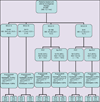Extrahepatic metastases occur in a minority of hepatocellular carcinoma patients treated with locoregional therapies: analyzing patterns of progression in 285 patients
- PMID: 22109811
- PMCID: PMC3322252
- DOI: 10.1002/hep.24812
Extrahepatic metastases occur in a minority of hepatocellular carcinoma patients treated with locoregional therapies: analyzing patterns of progression in 285 patients
Abstract
Although most cancers are considered predominantly systemic processes, this may not hold true for hepatocellular carcinoma (HCC). The literature regarding patterns of progression of HCC (local versus systemic) has been relatively sparse. Our objectives were to: (1) analyze patterns of progression in HCC patients presenting with intrahepatic disease from initial treatment until death, and (2) identify clinically relevant risk factors for the development of metastases. Over a 9-year period, 285 patients treated with transarterial locoregional therapies underwent scheduled imaging follow-up from treatment until death and were categorized by pattern of progression: (i) intrahepatic (increased tumor enhancement/size, development/progression of vascular invasion, new hepatic lesions) progression or (ii) extrahepatic (adrenal/bone/lung/lymph node) metastases. Uni/multivariate analyses assessing the risk factors for the development of metastases were performed. The median time from last scan to death was 2.4 months (interquartile range: 1.3-4.8 months). The time to development of metastases, vascular invasion, and/or new lesions was 13.8 months (confidence interval: 11.3-17.7 months). Of the 209 patients followed until death, only 50 developed extrahepatic metastases (24%). Multivariate analyses identified age <65 years (P = 0.038), alpha-fetoprotein >200 ng/mL (P = 0.04), and vascular invasion (P = 0.017) as significant predictors of metastases development.
Conclusion: Knowledge of the risk factors associated with the development of metastases may help guide assessment of patient prognosis. Because 76% of patients presenting with local disease treated with locoregional therapies die without developing extrahepatic metastases, the notion of HCC as a systemic disease, as detected by imaging, may be reconsidered.
Copyright © 2011 American Association for the Study of Liver Diseases.
Conflict of interest statement
Conflict of Interest: none
Figures


References
-
- Parkin DM, Bray F, Ferlay J, Pisani P. Estimating the world cancer burden: Globocan 2000. Int J Cancer. 2001;94:153–156. - PubMed
-
- Parkin DM, Bray F, Ferlay J, Pisani P. Global cancer statistics, 2002. CA Cancer J Clin. 2005;55:74–108. - PubMed
-
- Bosch FX, Ribes J, Diaz M, Cleries R. Primary liver cancer: worldwide incidence and trends. Gastroenterology. 2004;127:S5–S16. - PubMed
-
- Hussain SM, Zondervan PE, JN IJ, Schalm SW, de Man RA, Krestin GP. Benign versus malignant hepatic nodules: MR imaging findings with pathologic correlation. Radiographics. 2002;22:1023–1036. discussion 1037-1029. - PubMed
Publication types
MeSH terms
Grants and funding
LinkOut - more resources
Full Text Sources
Medical
